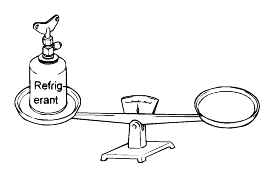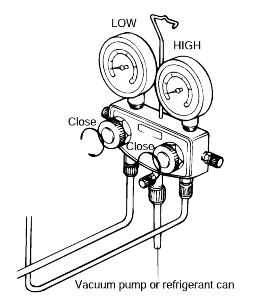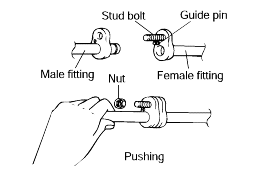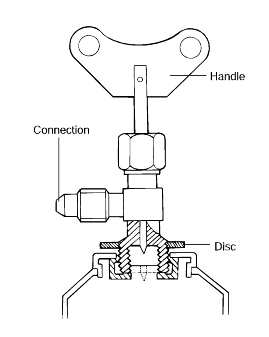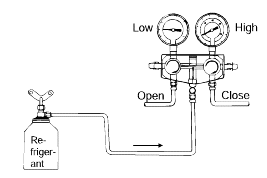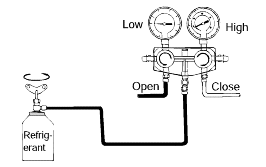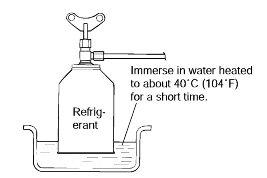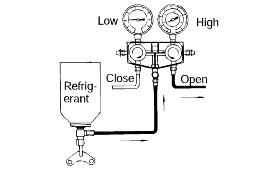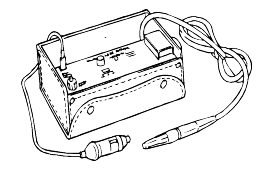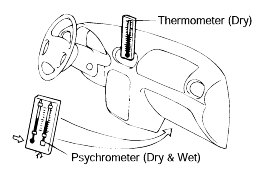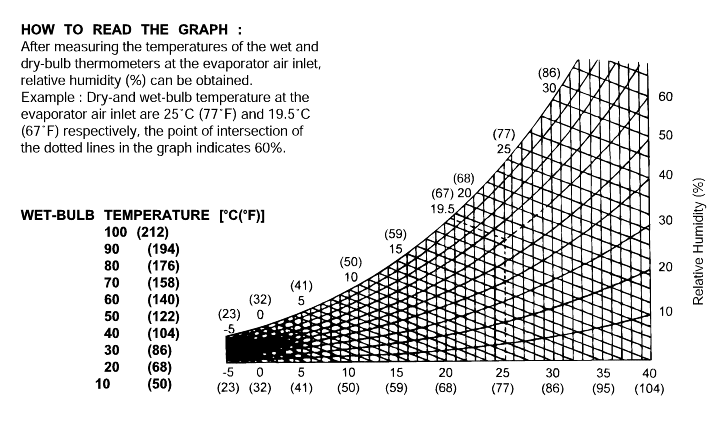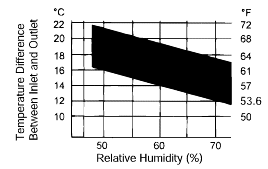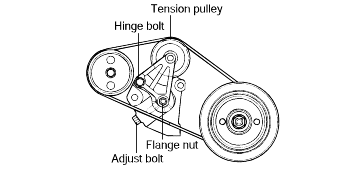The test gauge indicators shown in the following chapter are to be used as typical examples of common problem, which you may need to diagnose.
GAUGE READINGS | OTHER SYMPTOMS | DIAGNOSIS | CORRECTION |
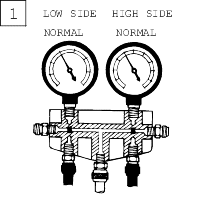 | ● Discharge air: slightly cool ● Thermostatic switch (with thermistor): Low side gauge doesn't fluctuate with switch "ON" and "OFF" cycle. | Some air and moisture in system | 2. Discharge refrigerant from system. 4. Replace receiver-drier. The drier is probably saturated with moisture. 5. Evacuate the system for at least 30 minutes. 6. Charge system with refrigerant. 7. Operate system and check performance. |
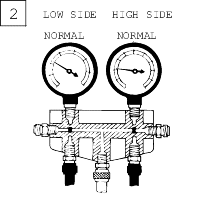 | ● Discharge air: Becomes warm as low side cycles into vacuum. ● Discharge air: Becomes warm all the time during hot part of day. | Excessive moisture in system. | 3. Evacuate system with a vacuum pump. 4. Recharge system to proper capacity. 5. Operate system and check performance. |
 | ● Compressor: Cycles on and off too fast. ● Low side gauge: Not enough range shown on low side gauge. | Defective thermostatic switch | 1. Stop engine and turn air conditioning "OFF". 2. Replace thermostatic switch when installing new thermostatic switch. Make sure that thermister tube is installed in the same position and to the same depth in evaporator core as old switch tube. 3. Operate system and check. |
 | ● Compressor: low side pressure builds too high before compressor turns on (cycle "ON" point too high) | Faulty thermostatic switch | 1. Stop engine and turn air conditioning "OFF". 2. Repair or replace thermostatic switch with thermistor (make sure that all wiring is positioned so that no short circuiting can occurred). 3. Operate system and check performance. |
 | ● Discharge air: Slightly cool. | System slightly low on refrigerant. | 4. Check compressor oil level. 5. Evacuate system using a vacuum pump. 6. Charge system with refrigerant. 7. Operate system and check performance. |
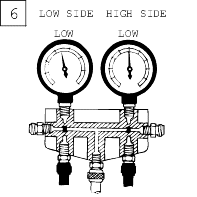 | | ● System very low on refrigerant. | 2. Leak test compressor seal area very carefully. 4. Check compressor oil level. 5. Evaporate system using a vacuum pump. 6. Charge system with refrigerant. 7. Operate system and check performance. |
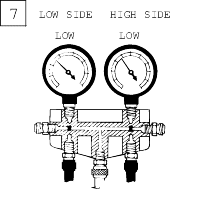 | ● Discharge air: Slightly cool. ● Expansion valve: Sweating or frost build up. | ● Expansion valve stuck closed. ● Sensing bulb malfunction. | 2. Discharge expansion valve, remove and inspect screen. 3. Clean and replace screen and reconnect screen. 4. Clean and replace screen and reconnect inlet line. 5. Evacuate system using a vacuum pump. 6. Charge system with refrigerant |
 | ● Discharge air: slightly cool. ● High side pipe: Cool and also shows sweating or frost. | Restriction in high side of system | 2. Remove and replace receiver-drier, liquid pipes or other defective components. 3. Evacuate system using a vacuum pump. 4. Charge system with refrigerant. 5. Operate system and check performance. |
 | | Compressor malfunction | 2. Remove compressor cylinder head and inspect compressor. 3. Check compressor oil level. 5. Operate system and check performance. |
 | | Malfunctioning condenser overcharge. | 1. Check for loose or worn fan belt. 2. Inspect condenser for clogged air passage. 3. Inspect condenser mounting for proper radiator clearance. 4. Check for refrigerant overcharge. 5. Operate system and check performance. |
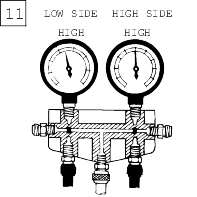 | ● Discharge air: Slightly cool. | Large amount of air and moisture. | 1. Discharge refrigerant from system. 2. Replace receiver-drier which may be saturated with moisture. 3. Evacuate system using vacuum pump. 4. Charge system with refrigerant. 5. Operate system and check performance. |
 | ● Evaporator: Sweating or frost. | Expansion valve stuck open | 2. Replace expansion valve, making sure all contacts clean and secure. 3. Evacuate system using vacuum pump, then recharge system with refrigerant. 4. Operate system and check performance. |
